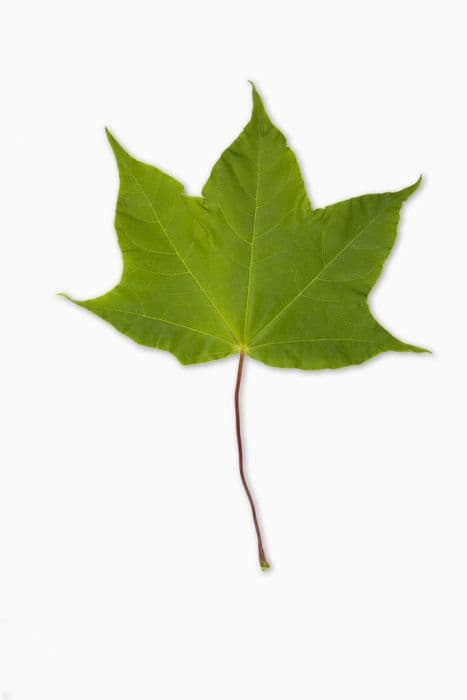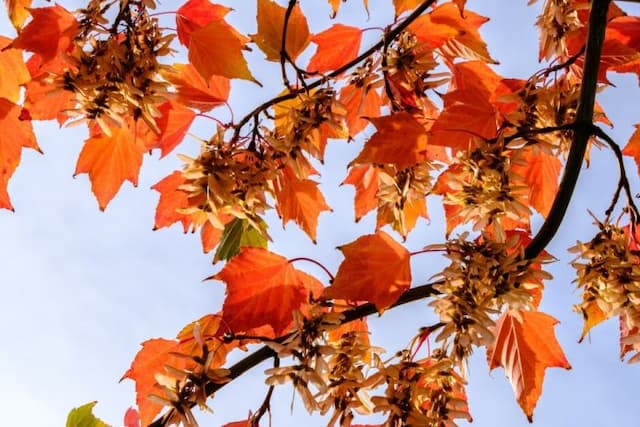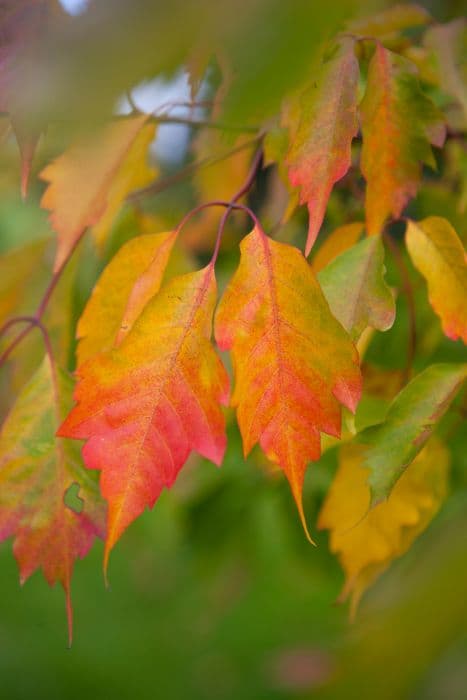Red Maple Acer rubrum Red Sunset = 'Franksred'
![red maple [Red Sunset]](/_next/image?url=https%3A%2F%2Fplants-admin.emdemapps.com%2Fimages%2Fplants%2F%2Fimages%2F604b5503d65e0.png&w=3840&q=75)
ABOUT
Acer rubrum Red Sunset, commonly known as the Red Sunset Maple, is a visually striking plant known for its vibrant aesthetic appeal throughout the seasons. This variety of maple presents a classic deciduous tree form with a rounded to oval crown. Its leaves are the signature attribute, with three to five pointed lobes, giving them a star-like shape. The foliage emerges with a slight reddish tint in spring, transitions to a lush green in summer, and culminates in a brilliant display of reds and oranges in the fall. When autumn arrives, the Red Sunset Maple truly lives up to its name, as the leaves take on a fiery hue that can be seen from a distance. Branches of this maple extend gracefully from the central trunk, often creating a symmetrical silhouette that adds to its ornamental value. The bark of the plant is also noteworthy, showcasing a light grey surface that provides winter interest when the leaves have fallen. Flowers of the Red Sunset Maple are small and red, appearing in early spring before the leaves. These give way to the helicopter-like winged fruits called samaras, which start out red and then turn to tan as they mature. These samaras hold the seeds, which are distributed by the wind. Overall, the Red Sunset Maple's stunning color transformations and appealing structure make it a desirable addition to any landscape focused on year-round visual impact.
About this plant
 Names
NamesFamily
Sapindaceae
Synonyms
Red Sunset Maple, Red Sunset Red Maple, Franksred Red Maple
Common names
Acer rubrum 'Franksred'.
 Toxicity
ToxicityTo humans
The Red Maple, specifically Acer rubrum Red Sunset = 'Franksred', is not generally considered toxic to humans. However, ingestion of significant quantities of its leaves or seeds, especially by small children, might cause digestive upset or mild symptoms such as stomach ache or diarrhea. These instances are rare and often require eating large amounts of plant material, which is unlikely. Still, it is always advisable to prevent children from ingesting parts of any ornamental plants due to potential unknown reactions or choking hazards.
To pets
In pets, particularly horses, the Red Maple can be toxic. Ingestion of wilted or dried leaves by horses can lead to a condition known as red maple leaf poisoning, marked by symptoms such as lethargy, increased heart rate and respiratory rate, jaundice, dark brown urine, and potentially, anemia due to the destruction of red blood cells. Goats and cows might also be affected to a lesser degree. It is crucial to prevent access of pets, especially horses, to the leaves of the Red Maple, particularly during the fall when leaves are likely to fall and dry out.
 Characteristics
CharacteristicsLife cycle
Perennials
Foliage type
Deciduous
Color of leaves
Green
Flower color
Red
Height
40-50 feet (12-15 meters)
Spread
30-40 feet (9-12 meters)
Plant type
Tree
Hardiness zones
4-9
Native area
North America
Benefits
 General Benefits
General Benefits- Vibrant Autumn Foliage: Red maple 'Red Sunset' is renowned for its stunning red and orange fall color, which provides spectacular landscape interest.
- Adaptable Growth: It can thrive in a wide range of soil types, from wet to dry, making it suitable for various landscape conditions.
- Shade Provision: Its broad canopy offers ample shade, reducing heat in surrounding areas during hot summer months.
- Wildlife Attraction: The tree produces seeds that are a source of food for birds and small mammals.
- Erosion Control: The robust root system helps to stabilize soil and prevent erosion.
- Fast Growth: Red maple 'Red Sunset' has a relatively quick growth rate, which means it can provide benefits such as shade and aesthetic appeal sooner than some other trees.
- Year-Round Interest: In addition to its fall colors, the tree has attractive red flowers in spring and a pleasing canopy structure in winter.
- Urban Tolerant: It is relatively tolerant of urban conditions, such as pollution and compacted soil, making it a good choice for city planting.
- Low Maintenance: Once established, it requires minimal care, making it an ideal choice for those looking for a low-maintenance landscaping option.
- Provides Habitat: The tree's structure provides nesting sites and cover for various bird species throughout the year.
 Medical Properties
Medical PropertiesThis plant is not used for medical purposes.
 Air-purifying Qualities
Air-purifying QualitiesThis plant is not specifically known for air purifying qualities.
 Other Uses
Other Uses- Acer rubrum is sometimes used in syrup production, though not as commonly as its cousin the sugar maple; in certain conditions, it can produce a similarly sweet sap.
- The wood of Acer rubrum "Red Sunset" can be used for woodworking and turning, creating items such as bowls, small furniture, and decorative pieces.
- In landscaping, the tree's vibrant fall color serves as excellent natural decor for autumn-themed events or photo shoots.
- Acer rubrum leaves can be pressed or preserved to create botanical artwork or to be used as teaching tools in educational settings.
- During fall, the fallen leaves can be collected to create a natural mulch or compost, providing nutrients back to the garden or habitat.
- The tree's sap can sometimes be fermented to create a unique, though not traditional, type of wine.
- Its bark can be used in small-scale landscaping to create rustic looking paths or as an accent in rock gardens.
- Fallen branches of Acer rubrum can be repurposed as natural perches or climbing structures for pet birds or reptiles.
- The tree's strong limb structure is sometimes used for supporting treehouses or hanging garden ornaments.
- During the winter, its stark silhouette against the sky can provide inspiration for photographers and artists looking to capture the beauty of the dormant season.
Interesting Facts
 Feng Shui
Feng ShuiThe Red Maple is not used in Feng Shui practice.
 Zodiac Sign Compitability
Zodiac Sign CompitabilityThe Red Maple is not used in astrology practice.
 Plant Symbolism
Plant Symbolism- Strength and Endurance: The Red Maple, including the Red Sunset variety, is a hardy species that can withstand various conditions, symbolizing the ability to endure and remain strong through adversity.
- Balance: Its leaves, which are symmetrically shaped, represent finding harmony and balance in life.
- Beauty and Change: The Red Sunset cultivar of the Red Maple is specifically known for its vibrant fall colors. This vivid transformation symbolizes the beauty of change and the passing of time.
- Welcoming: In some cultures, the Red Maple is seen as a welcoming symbol due to its widespread root system and inviting canopy.
- Canadian Identity: While the Red Sunset is not the national symbol, the Red Maple leaf is a significant emblem of Canada, reflecting a sense of belonging and national pride.
 Water
WaterThe Red Sunset Maple should be watered deeply once a week during dry periods, ensuring that the soil around its roots is moist but not waterlogged. In the early stages of growth or during the hotter seasons, you might need to increase the frequency to twice a week. A mature tree typically requires around 10 to 15 gallons per watering. Ensure that the water penetrates deeply into the soil, reaching down to the roots rather than just wetting the surface. During the winter or in periods of rainfall, you can reduce the watering as the tree will require less due to slower growth and natural precipitation.
 Light
LightThe Red Sunset Maple thrives best in full sunlight, so it's ideal to plant it in a spot where it gets direct sunlight for most of the day. A minimum of six hours of direct sunlight is preferable for optimal growth and color development. While it can tolerate some shade, too little sunlight may lead to reduced fall color vibrancy and can affect the overall health of the tree.
 Temperature
TemperatureThe Red Sunset Maple is hardy and can withstand a wide range of temperatures, from minimum lows of -40 degrees Fahrenheit to maximum highs reaching over 100 degrees Fahrenheit. However, the ideal temperature range for this maple is between 60 and 75 degrees Fahrenheit for optimal growth. It is a resilient species that adapts well to the seasonal temperature variations typical of many temperate regions.
 Pruning
PruningThe Red Sunset Maple should be pruned to maintain its shape and remove any dead or crossing branches, promoting healthy growth and airflow within the canopy. Pruning is best done in late winter or early spring before sap starts to flow. Avoid pruning in late spring or summer as it can lead to excessive sap loss. Regularly check for and remove broken or diseased limbs to maintain the tree's overall health.
 Cleaning
CleaningAs needed
 Soil
SoilRed Maple 'Red Sunset' thrives best in a well-drained, slightly acidic soil mix with a pH of 5.5 to 6.5. A good soil mix can be made by combining loamy garden soil, compost, and coarse sand or perlite to improve drainage.
 Repotting
RepottingRed Maple 'Red Sunset' is a large tree and typically does not need repotting as it is usually planted directly in the ground. If grown in a container, young trees may need repotting every 2-3 years until they are planted out.
 Humidity & Misting
Humidity & MistingRed Maple 'Red Sunset' is adaptable but prefers average to high humidity levels outdoors; it is not overly sensitive to humidity variations.
 Suitable locations
Suitable locationsIndoor
Not suited for indoor growth; requires outdoor conditions.
Outdoor
Plant in full sun to partial shade in moist, well-drained soil.
Hardiness zone
4-9 USDA
 Life cycle
Life cycleThe Red Sunset Maple (Acer rubrum 'Franksred') begins its life cycle as a dormant seed which germinates in the spring when soil temperatures warm up and moisture conditions are optimal. The seedling stage follows, where the plant develops its root system and initial leaves to start photosynthesis. As it matures into the sapling stage, its stem thickens, and it grows taller, developing characteristic maple leaves and branching patterns. The tree enters the juvenile phase, where it grows rapidly and begins to establish its final form, though not yet ready to reproduce. At maturity, which can take several years, the Red Sunset Maple reaches reproductive age, developing flowers in the early spring which are typically red and are followed by the production of samaras, or winged seeds, which disseminate in the wind. Throughout its adult life, the tree goes through annual cycles of growth, seed production, and dormancy in the winter, until, after many decades, it reaches the senescence stage and eventually dies.
 Propogation
PropogationPropogation time
Early spring
Propogation: The Red Sunset Maple, a cultivar of Acer rubrum, is generally propagated through softwood cuttings taken in late spring or early summer when the plant's growth is most vigorous. In this process, a 4 to 6 inch (10 to 15 cm) cutting is taken from a healthy branch, ensuring it has at least two to three sets of leaves. The bottom set of leaves is removed and the cut end is often dipped in a rooting hormone to encourage root development. The cutting is then planted in a well-draining soil mix and kept under high humidity, either by covering with a plastic bag or placing in a misting chamber. Roots usually develop within a few weeks, after which the new plant can be gradually acclimated to less humid conditions before being transplanted outdoors.









